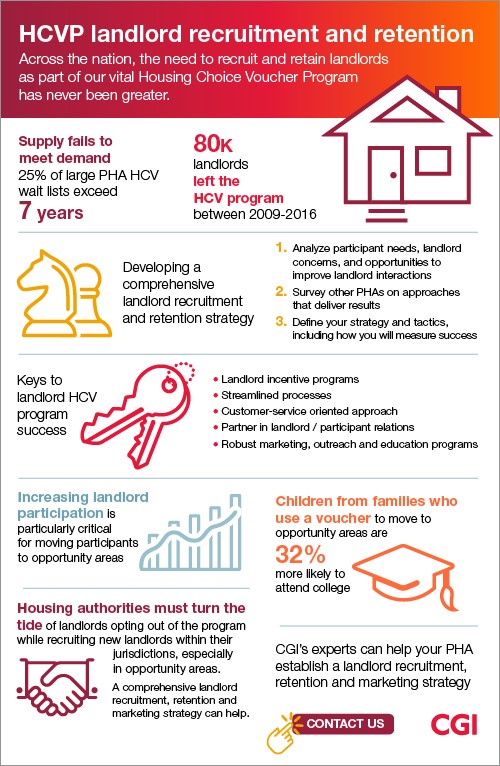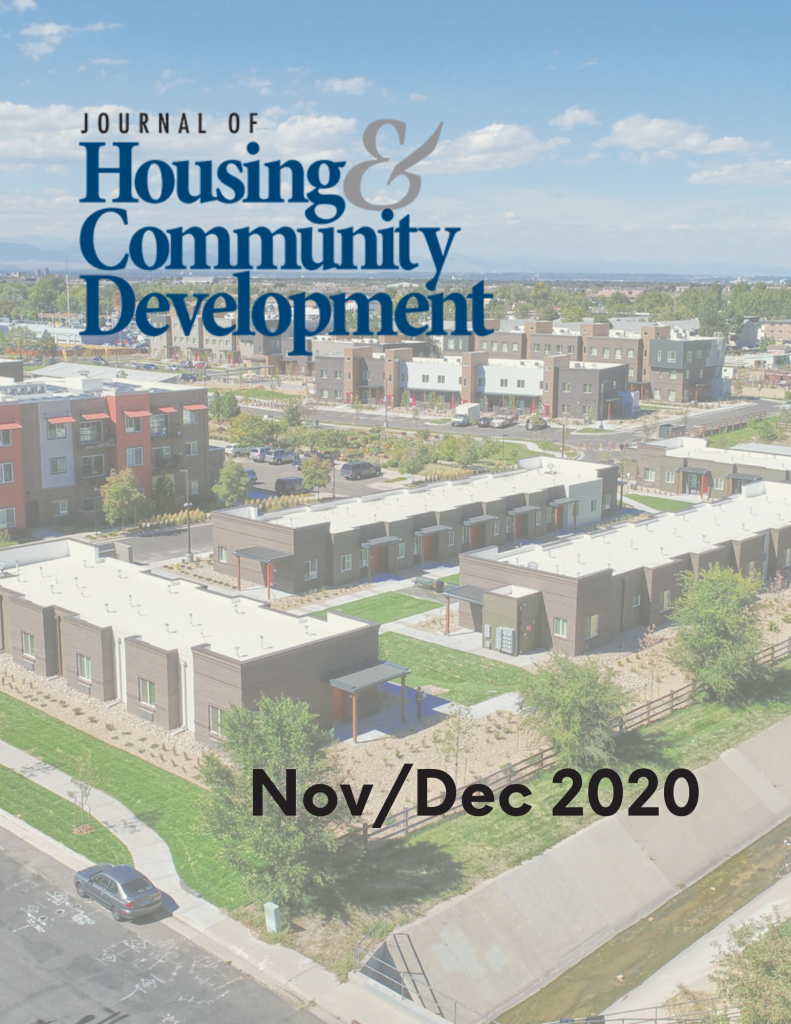Landlord Recruitment and Retention Strategies

The COVID-19 pandemic has wreaked havoc on the economy and the lives of working families, with resulting impacts to housing stability. Struggling with an ever-growing need for affordable housing options in their communities, public housing authorities (PHAs) are looking closely at the effectiveness of their efforts under the Housing Choice Voucher Program (HCVP). Over the past decade, the number of private landlords participating in the HCVP has continued to decline: HUD estimates that the voucher program lost 80,000 HCVP landlords between 2009 and 2016.
Surveys of landlords have provided some insights into why they left the HCVP and why so few new landlords have joined the program. Frequently cited challenges include administrative burden of working with PHAs, complex Housing Quality Standards (HQS) inspection processes, difficulty in relationships with participants and fair market rents (FMRs) that lag behind in a dynamic housing market.
HCVP executives are looking to address these challenges and develop new approaches to recruit and retain landlords to the program. Facing a rising need for stable and affordable housing, PHAs also recognize that recruiting new landlords—particularly in high opportunity areas—is imperative.
Recruiting and retaining landlords requires a targeted effort
With voucher holders taking longer to lease up and success rates for new voucher holders on the decline, housing authorities have implemented several programs to increase landlord interest in HCVP participation. To recruit new landlords, some PHAs have invested in one-time bonus payments for landlords new to the program. Some have conducted surveys of landlords who have left the program to understand their reasons for doing so. Other initiatives have focused on retaining current landlords through loyalty payment programs. These programs can produce results, but it has been difficult for PHAs to measure the relative value of these investments.
To accomplish their landlord retention and recruitment objectives, housing authorities need targeted strategies, informed by their unique community demographics and needs. Without a tailored approach for the unique aspects of their supported community, the PHA may end up investing valuable funds on efforts that do not deliver a return on their investment.

To access a webpage with this infographic, click here.
Launching a comprehensive recruitment and retention strategy
“To achieve the best outcomes from landlord recruitment and retention efforts, PHAs need to take a comprehensive approach,” said Amy Waxman, Director of Housing Choice Voucher Program services within CGI’s Affordable Housing Sector. “CGI has been working with PHAs to address these challenges and has developed a framework to enable a structured, outcome-based approach.”
First, per Waxman, conduct a detailed analysis of supply and demand factors. “This may include talking to landlords and participants about their experiences in order to develop a strategy for moving forward.” This foundational analysis should be augmented with additional analysis to obtain a fuller picture of the challenges associated with HCV participation. “We suggest expanding beyond supply and demand to include an operations analysis that examines current operations to serve landlords and what can be done to make it easier for landlords to navigate working with the housing authority,” Waxman noted.
Second, consider best practices and innovative models employed by other housing authorities. This type of analysis can reveal additional insights to inform areas for improvement in relationship management and operational efficiency, as well as avenues to make the program more competitive with the private market. “CGI’s relationships with PHAs across the nation provides us with a broad understanding of the market. When conducting this type of best practices and innovative models analysis, we engage PHAs of various sizes and demographics to obtain a more holistic view.”
Third, armed with specific findings from the supply side, demand side and operational analyses—and informed by best practices employed by other PHAs—develop a clearly defined strategy with specific tactics. “Because CGI’s team are experts in the affordable housing industry—many coming directly from years of leading initiatives at public housing authorities—the strategies we recommend are actionable, not theoretical,” said Waxman. “As a result, PHAs benefit from strategies and recommendations that can be quickly put into place.”
Another key element of the strategy is the ability to measure success. Waxman explained, “We encourage PHAs to identify the key metrics to measure the effectiveness of deployed initiatives. When establishing metrics, we suggest organizations consider the insights revealed during the supply- and demand-side analysis and collect data accordingly.” For example, PHAs may want to analyze effectiveness of programs in increasing landlord participation by landlord demographics (‘mom and pop’ landlords compared to corporate entities), reduction in lease-up times by geography and family composition, or program results in high opportunity areas compared to other areas of their jurisdiction.
Does your Housing Authority Need a Targeted, Comprehensive Strategy?
The success of HCVP and mobility initiatives relies upon the ability to recruit and retain landlords willing to participate in the program. Analysis of key metrics will enable PHA leaders to determine if the time is right for a more proactive, comprehensive strategy for engaging landlords. Waxman suggests the following key measures to consider:
- What are your PHA’s success rates?
- How many participants are asking for extensions?
- How many landlords are caneling Requests for Tenancy Approvals (RTAs)?
- What are your PHA’s trends in terms of number of landlords leaving and joining the voucher program year over year?
Taking a closer look at these metrics, PHA leaders may find that now is the time to take a more holistic approach to landlord recruitment, retention and marketing.
A housing program partner for over 30 years, CGI delivers consulting, technology and business process services to the federal government and public housing authorities. PHAs across the country partner with CGI for delivery of Housing Choice Voucher Program operations including tasks such as Housing Quality Standards Inspections, re-examination case management, wait list management, applicant processing and selection, eligibility determination, rent reasonableness reviews, landlord relations and payments, and more. CGI enables PHAs to continuously improve their programs and services through consultative support for critical functions such as program assessments and audits, SEMAP reviews, tenant mobility programs, tenant file audits, and landlord recruitment and outreach. In addition, our technology experts enable organizations to digitally transform their operations and improve program outcomes through advanced technologies such as online portals, systems modernization and integration, cloud-based solutions, and data-driven decision-making tools designed specifically for the affordable housing industry.
For more information visit https://www.cgi.com/us/en-us/federal/affordable-housing or email BPservices@cgifederal.com.
Follow CGI on social media:
- Twitter @CGI_USFederal
- Facebook @CGIUnitedStates
- Instagram @CGI_US
- Linked In CGI
More Articles in this Issue
NAHRO Honors Outstanding Professionals
On November 17, the National Association of Housing and Redevelopment Officials (NAHRO) honored two outstanding…From Homelessness to Home Construction in Salt Lake City
The Housing Authority of Salt Lake City wins a 2019 Award of Excellence in Resident and Client…NAHRO Announces 2020 Award of Excellence Winners
The National Association of Housing and Redevelopment Officials (NAHRO) recently awarded 21 prestigious Awards of Excellence to 18 housing…Commissioners Corner: Mitigating Fire Damage
As property owners and managers of buildings and homes in scattered-sites or other housing authority…Youth Take the Lead in Thomaston, Georgia
The Thomaston Housing Authority wins a 2019 Award of Excellence in Resident and Client Services for their dedication to overseeing…NAHRO Announces 2021 National Poster Contest Winners
Each year, NAHRO’s Housing America campaign holds a poster contest for children living in affordable housing owned or…Empowering Youth with Summer Food Programs
The City of Wichita wins a 2019 Award of Excellence in Resident and Client Services…





